We’d like to remind Forumites to please avoid political debate on the Forum.
This is to keep it a safe and useful space for MoneySaving discussions. Threads that are – or become – political in nature may be removed in line with the Forum’s rules. Thank you for your understanding.
ECP NTK for overstaying when store was closed
Comments
-
2, 4, 5 and 6 should be removed as they are old (do not win at POPLA) and there's no reason to not say you were driving, unless the NTK was non-POFA.
PRIVATE 'PCN'? DON'T PAY BUT DON'T IGNORE IT (except N.Ireland).
CLICK at the top or bottom of any page where it says:
Home»Motoring»Parking Tickets Fines & Parking - read the NEWBIES THREAD0 -
Thank you so much Coupon-mad. I will remove them now.Would you suggest submitting the POPLA appeal with this or are there anything else you think I can include?0
-
I think remove the clunky intro (we know you copied it from another one but it's written badly).
Then copy & paste the rest here for review, as more people will look at it in a reply than a link.PRIVATE 'PCN'? DON'T PAY BUT DON'T IGNORE IT (except N.Ireland).
CLICK at the top or bottom of any page where it says:
Home»Motoring»Parking Tickets Fines & Parking - read the NEWBIES THREAD0 -
I'm being limited by number of characters on the post. I'll split into multiple then.POPLA Verification Code: XXXXXXX
Vehicle Registration: XXXXXXX
I, the registered keeper of this vehicle, received a letter dated 07/07/2023 acting as a notice to the registered keeper. My appeal to the Operator – Euro Car Parks – was submitted and acknowledged by the Operator on 20/07/2023 and rejected via an email dated 28/07/2023. I contend that I, as the keeper, am not liable for the alleged parking charge and wish to appeal against it on the following grounds:
1. The entrance signs are inadequately positioned and lit and signs in this car park are not prominent, not clear nor legible from all parking spaces and there is insufficient notice of the sum of the parking charge itself 2. No Evidence of Landowner Authority - the operator is put to strict proof of full compliance with the BPA Code of Practice 3. The Signs Fail to Transparently Warn Drivers of what the ANPR Data will be used forrequirements
1. The entrance signs are inadequately positioned and lit and signs in this car park are not prominent, clear or legible from all parking spaces and there is insufficient notice of the sum of the parking charge itself
There was no contract nor agreement on the 'parking charge' at all. It is submitted that the driver did not have a fair opportunity to read about any terms involving this huge charge, which is out of all proportion and not saved by the dissimilar 'ParkingEye Ltd v Beavis' case.
In the Beavis case, which turned on specific facts relating only to the signs at that site and the unique interests and intentions of the landowners, the signs were unusually clear and not a typical example for this notorious industry. The Supreme Court were keen to point out the decision related to that car park and those facts only:
In the Beavis case, the £85 charge itself was in the largest font size with a contrasting colour background and the terms were legible, fairly concise and unambiguous. There were 'large lettering' signs at the entrance and all around the car park, according to the Judges.
Figure 1 below shows the 'Beavis case' sign as a comparison to the signs under dispute in this case:
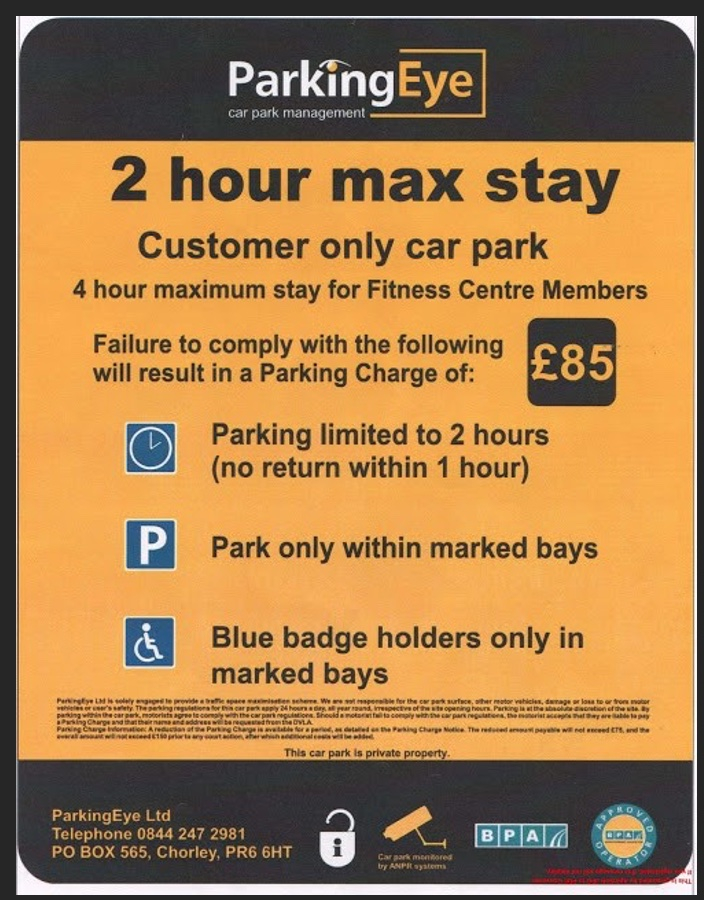
Figure 1: Beavis sign
This case, by comparison, does not demonstrate an example of the 'large lettering' and 'prominent signage' that impressed the Supreme Court Judges and swayed them into deciding that in the specific car park in the Beavis case alone, a contract and 'agreement on the charge' existed.
Here, the signs are sporadically and sparsely placed, indeed obscured and hidden in some areas. They are unremarkable, not immediately obvious as parking terms and the wording is mostly illegible, being crowded and cluttered with a lack of white space as a background. It is indisputable that placing letters too close together in order to fit more information into a smaller space can drastically reduce the legibility of a sign, especially one which must be read before the action of parking and leaving the car.
In their email rejecting the appeal, the operator states the following:
“Parking at the above site is limited to 180 minutes Monday to Saturday 06:00 hours to 21:00 hours / Sunday 10:00 hours to 18:00 hours. There is a maximum stay of 10 minutes outside of these hours”
As you will notice in the following evidence, there is no visible nor legible sign that allows a person to make note of the above stated restriction on any of the signs on site.
The allegation that “the vehicle was parked longer than 10 mins, therefore the notice was issued” is incorrect as all signs, as you will see from the evidence below, indicate maximum stay of 3 hours, with no specific mention of parking limited to the time indicated by the operator in their email (as mentioned above).
Euro Car Parks’ car park sign upon approach is on the left hand side of the narrow approach, which requires tremendous amount of focus by anyone driving so that they don’t bump their car into side barriers. The height barrier itself requires great attention at the entrance and to observe a sign on the left hand side of the vehicle is unsafe to say the least. The sign itself is inadequate and illegible in a number of ways, not least because of the sheer amount of text that must be read whilst navigating the height barrier and the very narrow entrance ramp (see Figure 2.1).
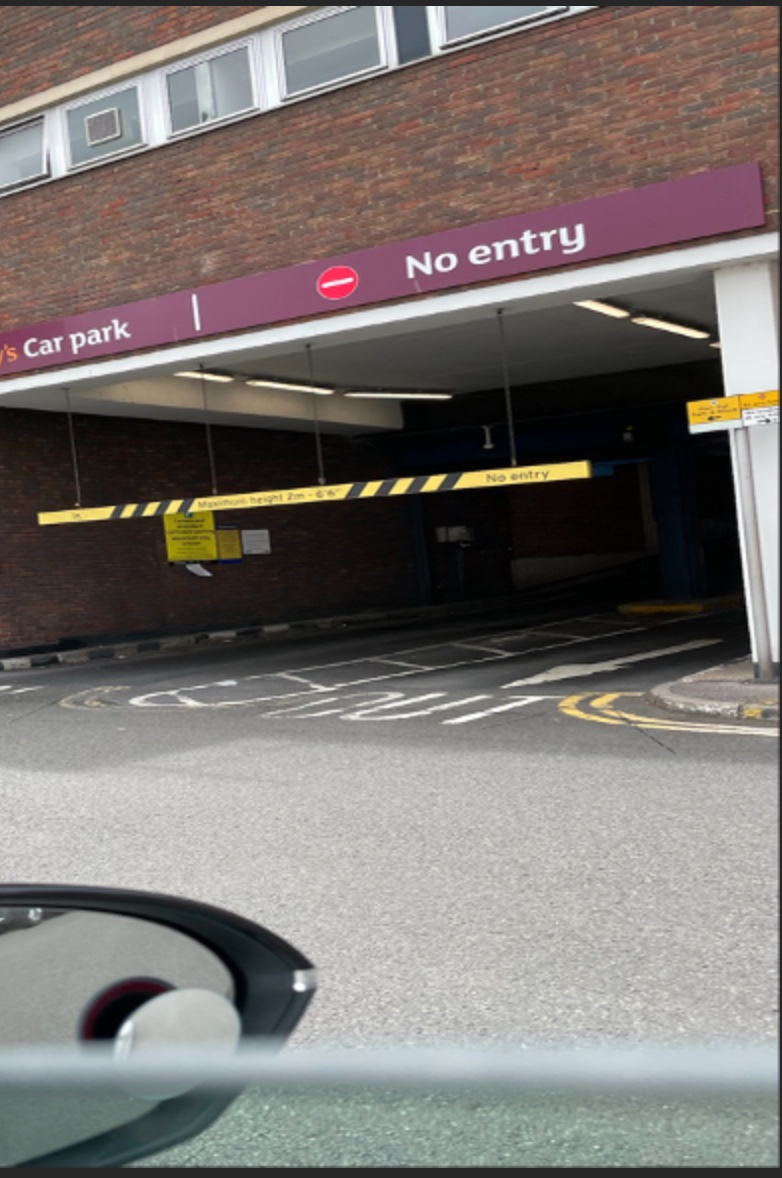
Figure 2.1: Sign upon approach
The image in Figure 2.2 shows the same sign appearing on the passenger side of the arriving vehicle, which indicates maximum stay of 3 hours, with any other text being illegible from point of reference when anyone is approaching the narrow ramp.
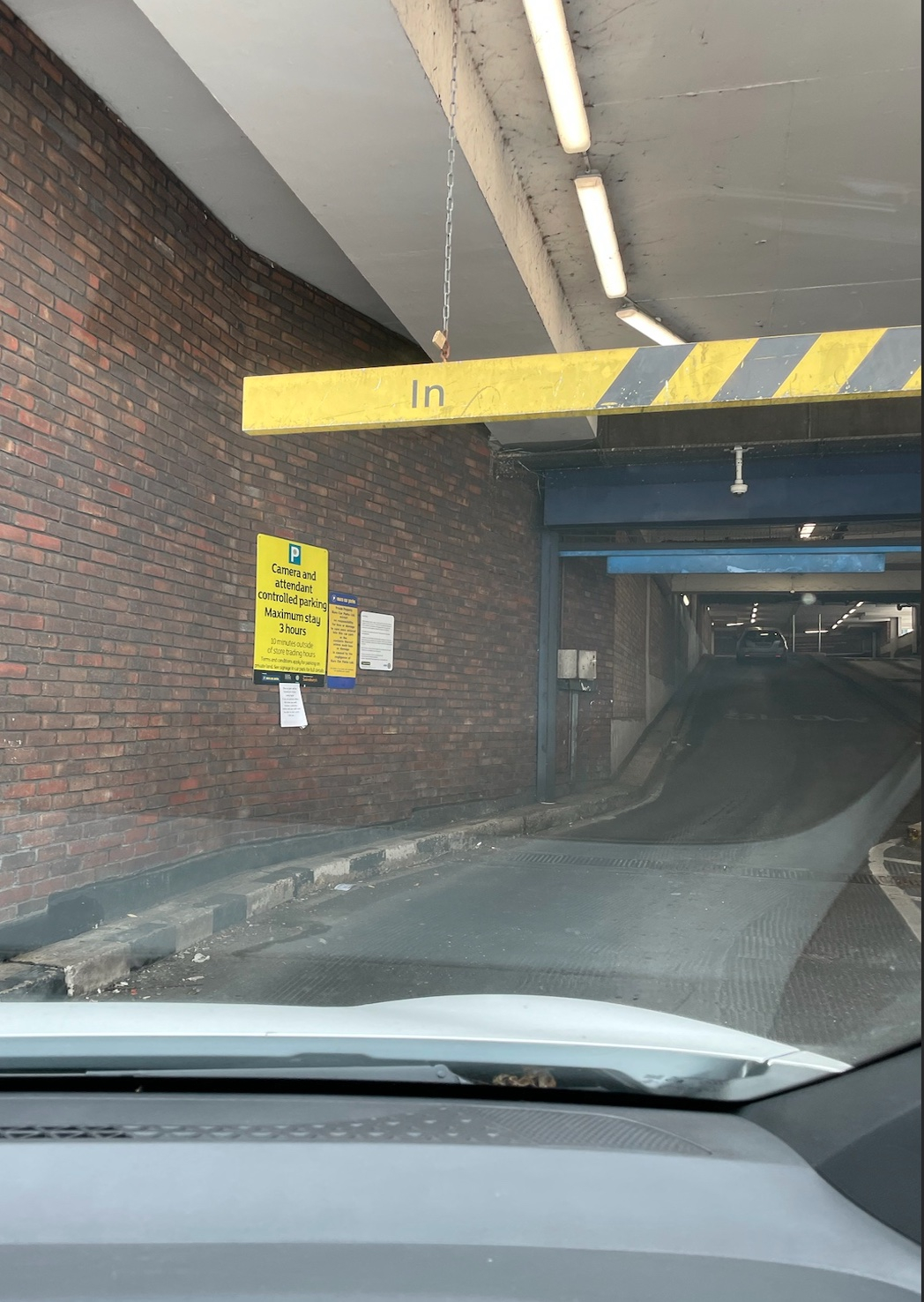
Figure 2.2: Sign upon approach
The image in Figure 2.3 shows a banner put up on the right hand side of anyone driving in, just as the vehicle needs to turn sharply to the left on a ramp with many pillars. Whilst extremely dangerous, it is unclear signage as it suggests 3 hours of parking at site. The signs indicated in Figure 2.2 and 2.3 cannot be read safely by any driver without their needing to look away from the road ahead.
This is clearly a violation of the below mentioned BPA code of practice requirement for entrance signs.
The BPA Code of Practice (Appendix
 sets the requirements for entrance signs. What is disputed are other requirements the BPA sets in Appendix B, specifically:
sets the requirements for entrance signs. What is disputed are other requirements the BPA sets in Appendix B, specifically: 1. The sign should be placed so that it is readable by drivers without their needing to look away from the road ahead.
2. Signs should be readable and understandable at all times, including during the hours of darkness or at dusk if and when parking enforcement activity takes place at those times. This can be achieved in a variety of ways such as by direct lighting or by using the lighting for the parking area. If the sign itself is not directly or indirectly lit, we suggest that it should be made of a retro-reflective material similar to that used on public roads and described in the Traffic Signs Manual.
In disputing points 1 and 2 above, the relevant entrance sign in this appeal case is not readable by drivers without their need to look away from the road ahead, nor is it readable and understandable at all times.
It is not directly lit nor does it benefit from lighting used for the parking area. It may well be made of a retro-reflective material but this is irrelevant in this case as the positioning of the entrance sign is as such that vehicle headlights will never shine on it sufficiently so as to illuminate it.
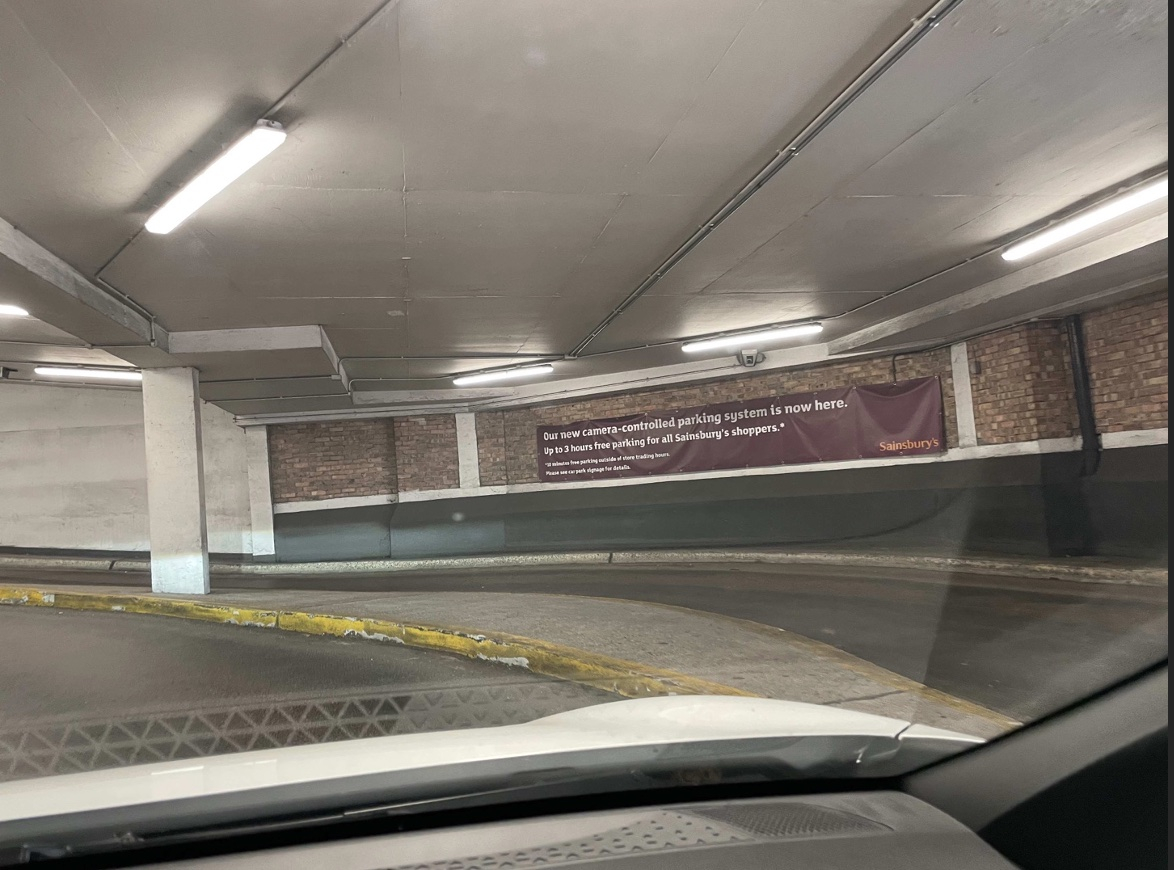
Figure 2.3: Poster on ramp at a sharp bend
0 -
Figure 3 shows a sign at about 10 feet distance that is barely legible from a parking spot. Figure 3 shows clear evidence that:
• The sign is positioned high on a wall, making it difficult to read.
• The terms are made even harder to read due to the positioning as they are positioned in driving path that is unsafe to approach as a pedestrian
• The sign is not lit from above but a tubelight serves merely to reflect on the glossy surface of the sign, again making it difficult to read.
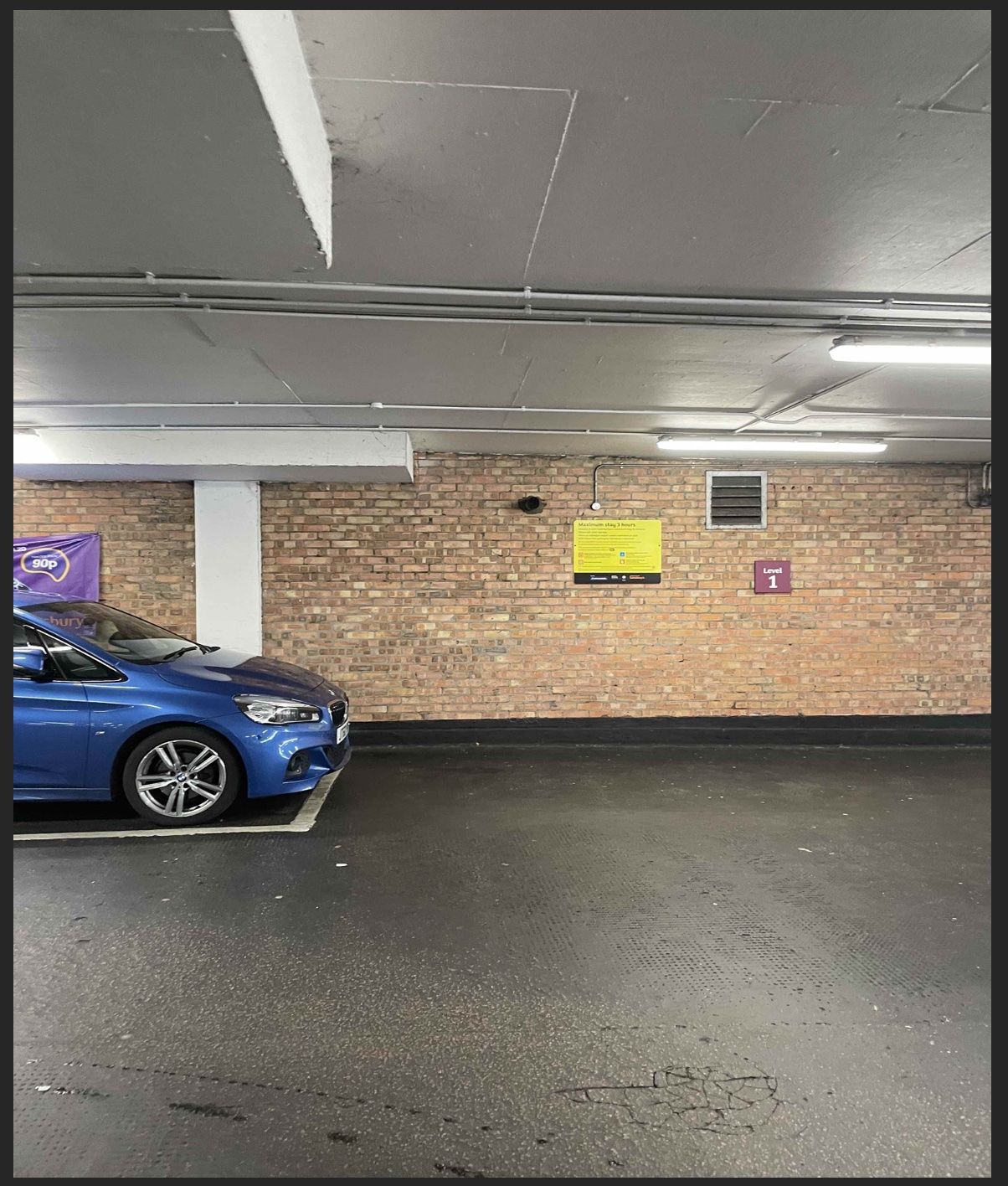
Figure 3: Sign from 10 ft distance
If one were to be brave and attempt to stand in the pathway of other drivers passing by in their cars to have a chance of having a closer look, Figure 4 shows that the only text that is barely legible is Maximum stay of 3 hours and this is at a distance of approx. 4 ft.
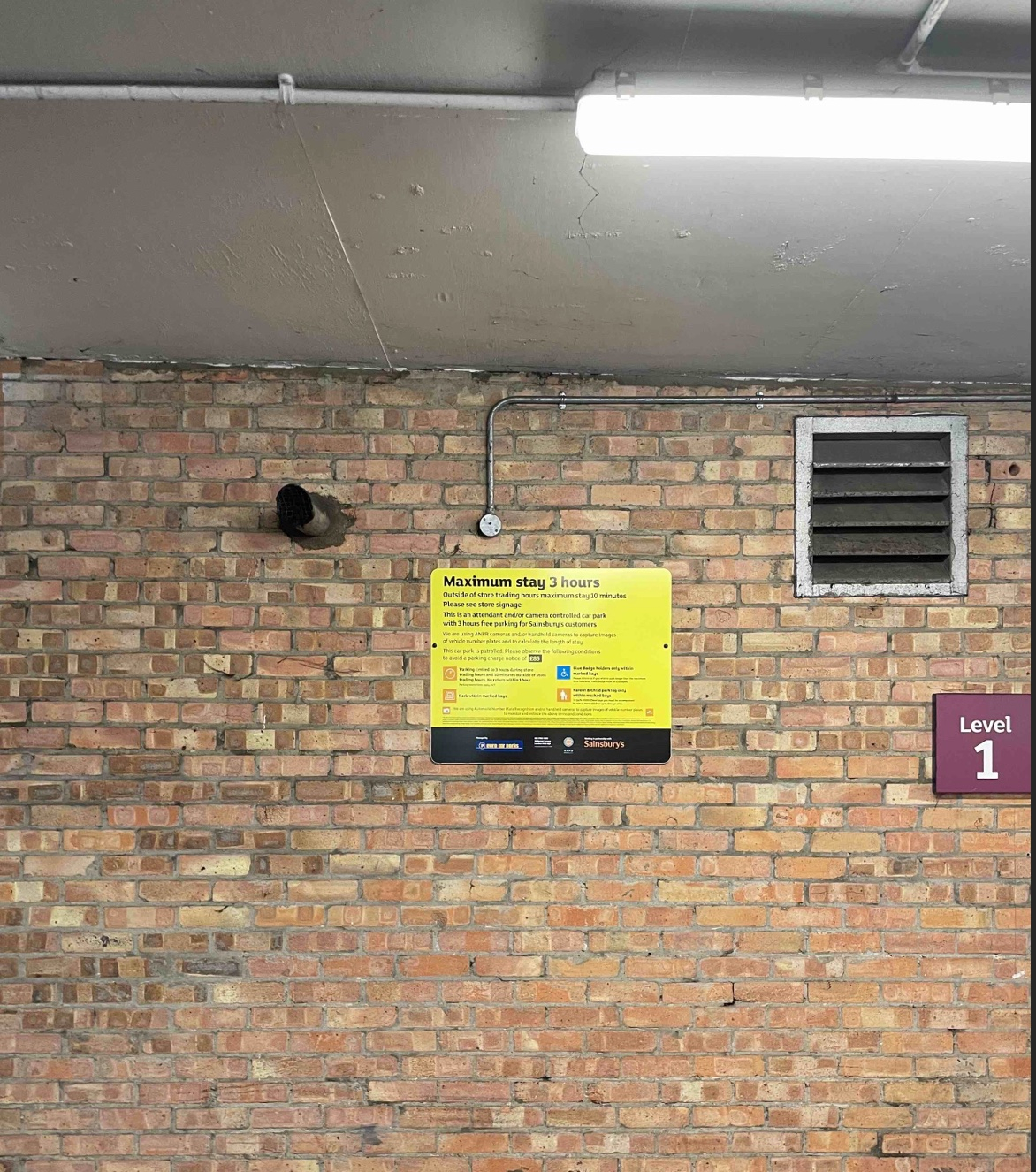
Figure 4: Sign from 4 ft distance
Figure 2.1, 2.2, 2.3, 3 and 4 clearly show that Euro Car Parks’ signage does not comply with the BPA Code of Practice (18.3), specifically:
“Signs must be conspicuous and legible, and written in intelligible language, so that they are easy to see, read and understand.”
There is no indication of any penalty applicable should the maximum stay be breached. Not “easy to see, read and understand”.
Any text barring Maximum stay 3 hours is almost impossible to read.
Why is something so important so small and illegible? The text is difficult to read, especially in low light conditions or with artificial light introducing a glare onto the reflective surface of the sign. And even then, the operating hours which has resulted in the alleged violation is not mentioned at all on any of the above signage on site.
Indeed, in relation to design principles, it is widely known that colour contrast plays a key role in terms of accessibility as it “affects some people’s ability to perceive information (in other words to be able to receive the information visually).” (Government Digital Service, 17 June 2016). Whilst this web page discusses design principles in relation to web design, the same points are true of print-based materials which would include signage.
Areas of this site are unsigned and there are no full terms displayed clearly indicating non-compliance with the BPA Code of Practice (18.3) which states:
“Specific parking-terms signage tells drivers what your terms and conditions are, including your parking charges. You must place signs containing the specific parking terms throughout the site, so that drivers are given the chance to read them at the time of parking or leaving their vehicle. Keep a record of where all the signs are. Signs must be conspicuous and legible, and written in intelligible language, so that they are easy to see, read and understand. Signs showing your detailed terms and conditions must be at least 450mm x 450mm.”
The entrance sign to the left of the entrance (from the perspective of a vehicle entering the car park) appears to contain a substantial amount of text. This text is very small – impossible to read whilst in a moving vehicle – and difficult to read in daylight whilst on foot (let alone from a moving vehicle at dusk). The sign contains a statement about liability in the event of theft from/damage to the vehicle whilst parked in the car park. It is arguably irrelevant to this appeal as it does not contain anything that suggests payment needs to be made or terms and conditions apply.
The entrance sign to the left of the entrance (from the perspective of a vehicle entering the car park) is the sign that states the car park is “Camera and Attendant controlled parking. Maximum stay 3 hours”. As previously discussed, the issue with this entrance sign is not compliance in terms of wording/format, nor positioning and illumination.
It is vital to observe, since 'adequate notice of the parking charge' is mandatory under the POFA Schedule 4 and the BPA Code of Practice, the signs in this car park do not clearly mention the parking charge which is hidden in small print. Large areas of this site are unsigned and there are no full terms displayed - i.e. with the sum of the parking charge itself in large lettering – NOT at the entrance either, nor the operating hours, so it cannot be assumed that a driver drove past and could read a legible sign, nor parked near one.
This case is more similar to the signage in POPLA decision 5960956830 on 02/06/16, where the Assessor Rochelle Merritt found as fact that signs in a similar size font in a busy car park where other unrelated signs were far larger, was inadequate:
''the signage is not of a good enough size to afford motorists the chance to read and understand the terms and conditions before deciding to remain in the car park. [...] In addition the operators signs would not be clearly visible from a parking space [...] The appellant has raised other grounds for appeal but I have not dealt with these as I have allowed the appeal.''
From the evidence I have seen so far, the terms appear to be displayed inadequately, in letters no more than about half an inch high, approximately. I put Euro Car Parks to strict proof as to the size of the wording on their signs and the size of lettering for the most onerous term, the parking charge itself.
The letters seem to be no larger than .40 font size going by this guide:
http://www-archive.mozilla.org/newlayout/testcases/css/sec526pt2.htm
As further evidence that this is inadequate notice, Letter Height Visibility is discussed here:
http://www.signazon.com/help-center/sign-letter-height-visibility-chart.aspx
''When designing your sign, consider how you will be using it, as well as how far away the readers you want to impact will be. For example, if you are placing a sales advertisement inside your retail store, your text only needs to be visible to the people in the store. 1-2” letters (or smaller) would work just fine. However, if you are hanging banners and want drivers on a nearby highway to be able to see them, design your letters at 3” or even larger.''
...and the same chart is reproduced here:
http://www.ebay.co.uk/gds/Outdoor-Dimensional-Sign-Letter-Best-ViewingDistance-/10000000175068392/g.html
''When designing an outdoor sign for your business keep in mind the readability of the letters. Letters always look smaller when mounted high onto an outdoor wall''.
''...a guideline for selecting sign letters. Multiply the letter height by 10 and that is the best viewing distance in feet. Multiply the best viewing distance by 4 and that is the max viewing distance.''
So, a letter height of just half an inch, showing the terms and the 'charge' and placed high on a wall or pole or buried in far too crowded small print, is woefully inadequate in an outdoor car park. Given that letters look smaller when high up on a wall or pole, as the angle renders the words less readable due to the perspective and height, you would have to stand right in front of it and still need a stepladder (and perhaps a torch and/or magnifying glass) to be able to read the terms.
Under Lord Denning's Red Hand Rule, the charge (being 'out of all proportion' with expectations of drivers in this car park and which is the most onerous of terms) should have been effectively: 'in red letters with a red hand pointing to it' - i.e. VERY clear and prominent with the terms in large lettering, as was found to be the case in the car park in 'Beavis'. A reasonable interpretation of the 'red hand rule' and the 'signage visibility distance' tables above and the BPA Code of Practice, taking all information into account, would require a parking charge and the terms to be displayed far more transparently, on a lower sign and in far larger lettering, with fewer words and more 'white space' as background contrast. Indeed in the Consumer Rights Act 2015 there is a 'Requirement for transparency':
1. A trader must ensure that a written term of a consumer contract, or a consumer notice in writing, is transparent.
2. A consumer notice is transparent for the purposes of subsection (1) if it is expressed in plain and intelligible language and it is legible.
The Beavis case signs not being similar to the signs in this appeal at all, I submit that the persuasive case law is in fact 'Vine v London Borough of Waltham Forest [2000] EWCA Civ 106' about a driver not seeing the terms and, consequently, she was NOT deemed bound by them.
This judgment is binding case law from the Court of Appeal and supports my argument, not the operator's case:
http://www.bailii.org/ew/cases/EWCA/Civ/2000/106.html
This was a victory for the motorist and found that, where terms on a sign are not seen and the area is not clearly marked/signed with prominent terms, the driver has not consented to - and cannot have 'breached' - an unknown contract because there is no contract capable of being established. The driver in that case (who had not seen any signs/lines) had NOT entered into a contract. The recorder made a clear finding of fact that the plaintiff, Miss Vine, did not see a sign because the area was not clearly marked as 'private land' and the signs were obscured/not adjacent to the car and could not have been seen and read from a driver's seat before parking.
So, for this appeal, I put this operator to strict proof of where the car was parked and (from photos taken in the same lighting conditions) how their signs appeared on that date, at that time, from the angle of the driver's perspective. Equally, I require this operator to show how the entrance signs appear from a driver's seat (not stock examples of 'the sign' in isolation/close-up), in the same lighting conditions. I submit that full terms simply cannot be read from a car before parking and mere 'stock examples' of close-ups of the (alleged) signage terms will not be sufficient to disprove this.
In addition, the BPA Code of Practice (18.1) clearly states that:
“A driver who uses your private car park with your permission does so under a licence or contract with you….In all cases, the driver’s use of your land will be governed by your terms and conditions, which the driver should be made aware of from the start.”
Bearing this paragraph in mind, there was categorically no contract established between the driver and Euro Car Parks. To draw on the basic guidelines of contract law for a contract to be effective the offer must be communicated.
Therefore, there can be no acceptance of an agreement if the other person is without knowledge of the offer.
When the driver arrived at the car park it was impossible to a read, let alone understand the terms and conditions being imposed. Upon further research it is apparent that the initial entrance signs in the car park are inadequate and poorly located (too high, on the passenger side of the vehicle, not visible from drivers side), invisible after dark and illegible at dusk(not lit, too high to be lit by virtue of reflecting any vehicle headlights, particularly from a moving vehicle entering the car park), and the terms and conditions illegible. As a result, the driver did not have a fair opportunity to read about any of the terms and conditions involving this charge.
2. No Evidence of Landowner Authority - the operator is put to strict proof of full compliance with the BPA Code of Practice
As this operator does not have proprietary interest in the land then I require that they produce an unredacted copy of the contract with the landowner. The contract and any 'site agreement' or 'User Manual' setting out details including exemptions - such as any 'genuine customer' or 'genuine resident' exemptions or any site occupier's 'right of veto' charge cancellation rights - is key evidence to define what this operator is authorised to do and any circumstances where the landowner/firms on site in fact have a right to cancellation of a charge. It cannot be assumed, just because an agent is contracted to merely put some signs up and issue Parking Charge Notices, that the agent is also authorised to make contracts with all or any category of visiting drivers and/or to enforce the charge in court in their own name (legal action regarding land use disputes generally being a matter for a landowner only).
Witness statements are not sound evidence of the above, often being pre-signed, generic documents not even identifying the case in hand or even the site rules. A witness statement might in some cases be accepted by POPLA but in this case I suggest it is unlikely to sufficiently evidence the definition of the services provided by each party to the agreement.
Nor would it define vital information such as charging days/times, any exemption clauses, grace periods (which I believe may be longer than the bare minimum times set out in the BPA Code of Practice) and basic information such as the land boundary and bays where enforcement applies/does not apply. Not forgetting evidence of the various restrictions which the landowner has authorised can give rise to a charge and of course, how much the landowner authorises this agent to charge (which cannot be assumed to be the sum in small print on a sign because template private parking terms and sums have been known not to match the actual landowner agreement).
Paragraph 7 of the BPA Code of Practice defines the mandatory requirements and I put this operator to strict proof of full compliance:
7.2 If the operator wishes to take legal action on any outstanding parking charges, they must ensure that they have the written authority of the landowner (or their appointed agent) prior to legal action being taken.
7.3 The written authorisation must also set out:
a. the definition of the land on which you may operate, so that the boundaries of the land can be clearly defined
b. any conditions or restrictions on parking control and enforcement operations, including any restrictions on hours of operation
c. any conditions or restrictions on the types of vehicles that may, or may not, be subject to parking control and enforcement
d. who has the responsibility for putting up and maintaining signs
e. the definition of the services provided by each party to the agreement.
0 -
3. The Signs Fail to Transparently Warn Drivers of what the ANPR Data will be used for.
The signs fail to transparently warn drivers of what the ANPR data will be used for which breaches the BPA Code of Practice and the Consumer Protection from Unfair Trading Regulations 2008 due to inherent failure to indicate the 'commercial intent' of the cameras.
Paragraph 21.1 of the BPA Code of Practice advises operators that they may use ANPR camera technology to manage, control and enforce parking in private car parks, as long as they do this in a reasonable, consistent and transparent manner. The Code of Practice requires that car park signs must tell drivers that the operator is using this technology and what it will use the data captured by ANPR cameras for.
Euro Car Parks’ signs do not comply with these requirements because these car park signage failed to accurately explain what the ANPR data would be used for, which is a 'failure to identify its commercial intent', contrary to the BPA CoP and Consumer law.
The Euro Car Parks’ sign on the entrance on the left side of the vehicle as it approaches the ramp states:
“Camera and attendant controlled parking. Maximum stay 3 hours.”
And the banner to the right side of the vehicle at a sharp left turn states:
“Our new camera-controlled parking system is now here.”Furthermore, the sign inside the parking area which can only be attempted to be read by zooming into images read:
“We are using ANPR cameras and/or handheld cameras to capture images of vehicle number plates to calculate the length of stay”Specifically missing from this sentence is the vital information that these camera images would be used in order to issue Parking Charge Notices. There is absolutely no suggestion in the sentence above that the cameras are in any way related to Parking Charge Notices. The only reference to Parking Charge Notices on Euro Car Parks’ sign makes no mention of Parking Charge Notices being issued as a result of images captured by the ANPR cameras and instead merely states (see Figure 2):
“This car park is patrolled, Please observe the following conditions to avoid a parking charge notice of £85.”
In circumstances where the terms of a notice are not negotiable (as is the case with the car park signage, which is a take-it-or-leave-it contract) and where there is any ambiguity or contradiction in those terms, the rule of contra proferentem shall apply against the party responsible for writing those terms.
This is confirmed within the Consumer Rights Act 2015 including: Paragraph 68: Requirement for Transparency:
(1) A trader must ensure that a written term of a consumer contract, or a consumer notice in writing, is transparent.
(2) A consumer notice is transparent for the purposes of subsection (1) if it is expressed in plain and intelligible language and it is legible.
and Paragraph 69:
Contract terms that may have different meanings:
(1) If a term in a consumer contract, or a consumer notice, could have different meanings, the meaning that is most favourable to the consumer is to prevail.
Withholding material information from a consumer about the commercial (not security) purpose of the cameras would be considered an unfair term under The Consumer Protection from Unfair Trading Regulations 2008 because the operator 'fails to identify its commercial intent':
http://www.legislation.gov.uk/uksi/2008/1277/contents/made
Misleading omissions: 6. - (1) ''A commercial practice is a misleading omission if, in its factual context, taking account of the matters in paragraph
(2) -
(a) the commercial practice omits material information,
(b) the commercial practice hides material information,
(c) the commercial practice provides material information in a manner which is unclear, unintelligible, ambiguous or untimely, or
(d) the commercial practice fails to identify its commercial intent, unless this is already apparent from the context, and as a result it causes or is likely to cause the average consumer to take a transactional decision he would not have taken otherwise.''
It is far from 'apparent' that a camera icon means a car's data is being harvested for commercial purposes of charging in a free car park. A camera icon suggests CCTV is in operation for security within the car park.
0 -
I think remove this section as that sentence doesn't help:"Furthermore, the sign inside the parking area which can only be attempted to be read by zooming into images read:
“We are using ANPR cameras and/or handheld cameras to capture images of vehicle number plates to calculate the length of stay”
Specifically missing from this sentence is the vital information that these camera images would be used in order to issue Parking Charge Notices. There is absolutely no suggestion in the sentence above that the cameras are in any way related to Parking Charge Notices. The only reference to Parking Charge Notices on Euro Car Parks’ sign makes no mention of Parking Charge Notices being issued as a result of images captured by the ANPR cameras and instead merely states (see Figure 2):
“This car park is patrolled, Please observe the following conditions to avoid a parking charge notice of £85.”
PRIVATE 'PCN'? DON'T PAY BUT DON'T IGNORE IT (except N.Ireland).
CLICK at the top or bottom of any page where it says:
Home»Motoring»Parking Tickets Fines & Parking - read the NEWBIES THREAD1 -
Thank you very much everyone. I've created a PDF with all the recommended changes and submitted the appeal from "Other" section of POPLA. Fingers crossed.2
-
No surprises @Coupon-mad , ECP has submitted a 36 page evidence pack. ECP Evidence
The comments I am currently thinking of:- The evidence provided does not indicate any image with the operating hours which in turn has lead to the alleged overstay.
- "
Parking at the above site is limited to 180 minutes Monday to Saturday 06:00 hours to 21:00 hours / Sunday 10:00 hours to 18:00 hours. There is a maximum stay of 10 minutes outside of these hours."
The above is NOT indicated anywhere on the site and is acknowledged by ECP by virtue of the submitted signage photographs
- By way of the images provided by ECP themselves, its abundantly evident that these signs are illegible and the only prominent wording suggests max stay of 3 hours (and the calculated stay by ANPR is 1h:59m
- The location of the signs at the entrance from the evidence itself indicates the erroneous positioning not allowing the driver a safe way to make notice of the signs, which are placed on the left hand/passenger side of the entering vehicle.
Any guidance for a rebuttal will be much appreciated.0 -
Are you saying not a single piece of evidence shows a sign with the term they say you breached?! Just say that to POPLA as your comments.PRIVATE 'PCN'? DON'T PAY BUT DON'T IGNORE IT (except N.Ireland).
CLICK at the top or bottom of any page where it says:
Home»Motoring»Parking Tickets Fines & Parking - read the NEWBIES THREAD0
Confirm your email address to Create Threads and Reply

Categories
- All Categories
- 352.8K Banking & Borrowing
- 253.8K Reduce Debt & Boost Income
- 454.7K Spending & Discounts
- 245.9K Work, Benefits & Business
- 601.9K Mortgages, Homes & Bills
- 177.8K Life & Family
- 259.8K Travel & Transport
- 1.5M Hobbies & Leisure
- 16K Discuss & Feedback
- 37.7K Read-Only Boards



